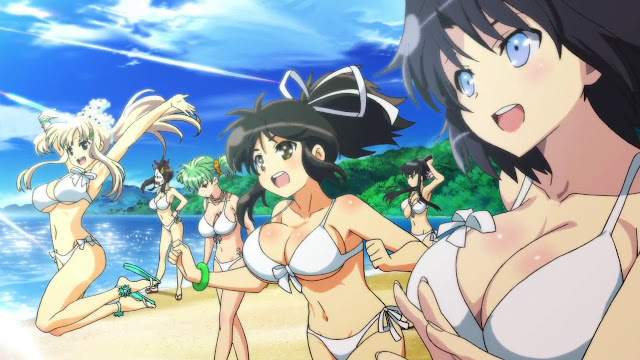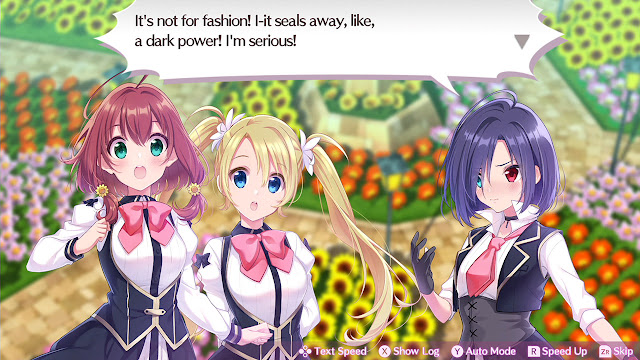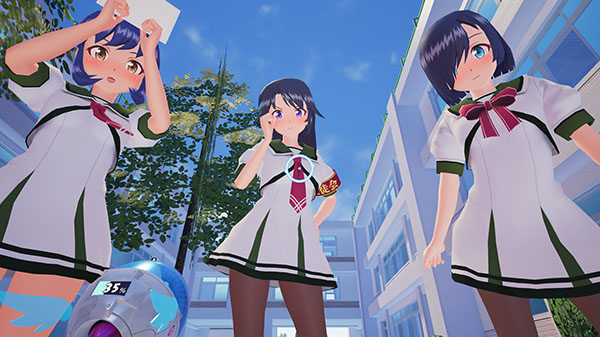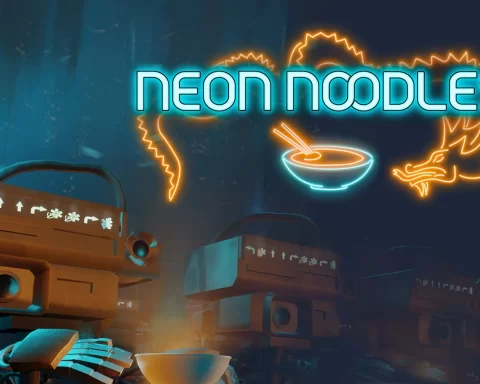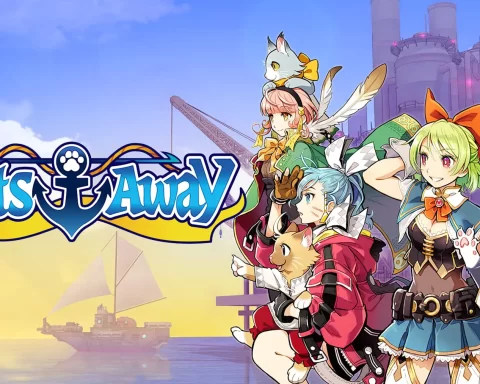by TsuChanJohnson
Editor’s intro: One of the most common discussions that continues to pop up every few months in video games is the way that some Japanese games depict female characters – particularly when they start wearing school uniforms or the anime aesthetic means that they look youthful. Every time it happens the same insufficient arguments are rolled out from all angles, so we got a philosopher to contribute a piece that we’ll be able to continue to refer to down the track in calling for a more nuanced and intelligent discussion around a challenging, but ultimately fascinating, point of discussion.
The time has come. Bring out the torches and pitchforks. The time has come, for us to group together, and stand strong against the forces of evil. The time has come for us to defend the fundamental values of our society that are in danger of being overthrown by a demonic opponent that lacks even the most basic, the most commonest of senses. We shall not back down. We shall march, as one, against these perverse predators wanting nothing but to abuse our children in their underground sex dungeons! I said, we shall march, as one, against these left-wing liberal SJW puritans forcing their twisted values onto our innocent fictional pixels, fundamentally undermining our right to freedom of speech! Uhm… Yeah. “Go team!” Right? Wait a second…
Sexualized imagery in our media is a sensitive topic, and probably will remain so for a long time. Sexualized imagery of minors even more so. All the more reason to tread carefully, engage in thoughtful conversation, and attempt to see what the world is like from each other’s perspectives. This way we can maybe rule out some of the most common bad arguments on either side of the debate, in effect perhaps de-polarize this ‘side-ism’, ever so averse to the power of nuance. Sadly, the power of nuance is not in mobilising street marches or, let’s be real here, Twitter-mobs. The power of nuance instead lies instead in providing an agreeable way forward in a diverse, pluralistic society. In this little piece right here I intend to discuss some of the common arguments in the debates surrounding the sexualization of fictional minors, most commonly as found in the Japanese games, anime and manga we have come to love so much (because yes, there do seem to be double standards with regards to popular opinion of Anglo-European depictions compared to Japanese(-inspired) depictions of a similar kind, but that’s a topic for some other time).
Argument #1 “It’s literal child porn!”
What I shall call the “it’s literal child porn” argument is one very common argument against the sexualized imagery of fictional minors. This is a very effective argument because it relies strongly on the heavy emotional response that child pornography and pedophilia evoke in our current society. The argument takes pedophilia to be evidently immoral, and the depictions in the media in question to be either similar enough or a direct instantiation of the category of ‘child porn’, depending on whether we take the argument to be hyperbole (which seems more charitable) or not. This argument then relies primarily on the extent to which the instantiation- or analogy-relation can be said to hold.
For the sake of argument, we need to ponder what exactly it is about child pornography that makes it immoral. I take there to be two sides to this: 1) the production that inevitably involves a horrible form of abuse, and 2) the consumption, as it involves an enjoyment of the immoral sexual actions depicted. This goes without saying for such illicit material involving actual minors. The analogy, however, fails on (1) as there are no minors involved in the production of the material. Depicted characters and activities are entirely fictional: no minors harmed in the process. The depictions in the merely sexually suggestive media we discuss here also don’t really match (2). Yet they are suggestive of more, so let’s get into an example of which the production only involved people of legal age, but that seem to depict sexual scenes as though they involved minors.
Consider this. A healthy young woman, say, 20 years old, has a petite body type and looks rather young. Say she is sexually active. Say she is interested in filming these acts. Say she likes to share them online. So far so good. Grown woman, capable of making her own sexual decisions and it is within her rights to film and share any depictions of herself wherever she would like. Say she likes to do this wearing particular sorts of clothing, taking on a particular sort of speech pattern as a form of roleplay. We’re still good. People can (and seem to) roleplay as whatever they want. Say the clothing and mannerisms are typically considered characteristic of a younger child: a minor. Because of the way she looks, she doesn’t just look like an ol’ lady wearing a school uniform: we’ll say it looks credible. I can imagine this might make many of us uncomfortable: the depiction now matches (2), though without matching (1). Yet surely we cannot restrict the woman’s clothing of choice or speech mannerisms as she engages in sexual activity she chooses to film and share. What she’s allowed to do should not depend on her body type. I’m reasonably sure we wouldn’t want to restrict people from wearing certain types of clothing depending on their body type. This means that, I suggest, we do sometimes accept cases that match (2) but not (1), even if we may find the depiction itself objectionable: disliking something as a personal response doesn’t equal it being immoral.
Say she’s an artist. Say she wants to draw out the scene she just acted out. The end result is, essentially, smut with a depiction of a minor engaging in sexual activities. I’m fairly sure plenty of people would find this objectionable. But is it immoral? We followed the exact same steps as above, which were all fine. It seems rather strange if suddenly if she would draw out her piece (in a sense distancing it further from reality), what she’s doing becomes wrong. Surely we can’t limit the right to self-portrait to people that look to those that can’t be mistaken for minors?
Now take it back to our case in question. I suggest it is closer to the young woman’s self-portrayal than it is to clearly illicit activity. Closer, but not identical, because the people depicted are literally fictional, and not based on anyone’s actual portrayal. Closer, but not identical, also because the activities are sexually suggestive. In more extreme versions it is quite literally suggestive (take Valkyrie Drive’s touching minigame), and in tamer versions it may be limited to showy clothing and a suggestive pose or angle (take Dead or Alive Xtreme for example). It seems to me that the ‘safer’ and ‘tamer’ the piece of media gets, the less potentially ‘objectionable’ it becomes. There may be reasons to consider restricting the accessibility to merely objectionable material; we’ll get into this below at Argument #3. In sum, there are certainly features of Valkyrie Drive and Dead or Alive that some may find objectionable. That’s fine, I find extreme displays of violence objectionable and I know someone that finds people crossing the red line extremely objectionable. This doesn’t necessarily mean it is immoral to produce this material, nor is it necessarily immoral to enjoy it. It’s just not that simple.
Argument #2 “They’re just pixels!”
The second argument, which I call the ‘they’re just pixels’ argument, is in favour of the permissibility of sexualized depictions of fictional minors. The argument is about equivalent to the, admittedly less snappy, ‘opponents can’t distinguish between reality and fiction’ or ‘they’re trying to argue for human rights for fictional characters’ arguments. The basic intuition is that fictional characters can’t hurt, and therefore ‘anything goes’. Surely we won’t sue the writers of Suikoden for killing Gremio (but maybe we should), and in this sense it is totally fair that authors shouldn’t be punished for what they do to their fictional characters. But, this does not mean necessarily that just anything goes. As seen in the discussion of Argument 1, things may be harmless on the ‘production’ side of things. Yet this does not mean it is all harmless on the ‘consumption’ side of things. In much the same way, we may want to limit the production of lethal weapons even if they are produced ethically.
The primary issue is that this argument chooses to ignore the effects that images have on the people that engage with them. This also goes for the ‘if you don’t like it, don’t buy it’ argument. Recall the last time you cried playing a game, reading a book or watching a movie. Recall the last time you absolutely hated a character for being an absolute dense idiot. Recall the last time you could not but appreciate the friendship gained through the hardships the characters gained through time. Recall the last time you saw an absolute hunk or babe on your screen and thought they looked, well… you know, nice. The notion that fictional depictions are harmless tout court when produced harmlessly is naive in that we all know fictions affect us. Sometimes it’s momentary and forgotten soon after. Sometimes it lasts. I still remember the lesson from Togami Byakuya to not judge someone else by your own standards, and I try to put that into practice whenever I can.
It is easy to think of personal, emotional ways that fictions have affected us short and long term, but our cultural narratives also heavily influence the way we become enculturated. The stories we engage with help shape our values and are of incredible importance on how we view the world. If this seems rather unscientific to you (which it isn’t, really, the importance of narrative practices is a significant research field in developmental psychology), consider all the money the US military has put into American military shooters, hoping to desensitise the youth to the horrors of war, increasing their likelihood to sign up. Narratives play a crucial role in determining what we individually deem okay and what we don’t. This is not to say it’s the single determinant. It’s a thread woven by a variety of interrelated practices and experiences that range from guidance from caretakers and the perception of others like you to the way you had it at school, your sports club or your music institution. In fact, the extent to which we’re prone to certain well known visual illusions may very well be related to the particular sociocultural environments we grow up in too!
The obvious next question is: what effect does this imagery have on us? This is hard to say, as it’s technically an empirical question, which I’ll touch on more right down at the bottom of this piece. “Empirical” means that it’s a question about the way things are in our world; not something to be solved by argument, but by scientific research instead. Currently, we don’t have any clear data on the effects that the currently available sexually suggestive fictional media have on people, and it’s a difficult matter to study to boot. It is reasonable to think that at the very least normalizes some of the things depicted, but it’s not clear how this works for anime-styled media. Does it only attune us to sexually suggestive pieces in anime-styled media, or does it extend to our anticipations in real-world interactions? This may differ per person, but I won’t speak on the statistically average accommodation of these regularities in our anticipations. What we can say, however, is that we can’t simply wave away possible effects that certain imagery might have, and we should be careful in the roles we let certain imagery have in our narrative practices. This goes of course for the ways we portray wars, demonise (and dehumanise) ‘enemies’, but also, most certainly, for the ways we portray sexuality. It’s just not that simple.
Argument #3 “Think of the children!”
The third argument, the “think of the children” argument sort of speaks for itself. The intuition is that the particular media may have a negative effect on the way children learn to engage with sexuality. This was explicitly cited as one of the reasons Omega Labyrinth Z was rejected classification in the UK, for example. There is some real push for this particular line of argument rising up from the above discussions: we may indeed need to restrict access to something objectionable (as seen in Argument 1) and narratives are indeed crucial in shaping our developmental trajectory (as seen in Argument 2). Does playing the latest (digitally legally published) Omega Labyrinth Life mean we’re not thinking of the children?
I’m gonna give a wild suggestion here and say it’s not that simple. I most certainly agree with the UK’s rating board that Omega Labyrinth Z is likely harmful to the sexual development of children. It may prepare someone for a wildly different sexual experience than the one in the real world. I imagine your favourite military shooter has similarly negative effects on the youth. Does it turn them into killers? No, not necessarily. But it may very well aid in desensitisation to violent crime or the killings of dehumanised ‘enemies’. Again there’s an empirical question currently unanswered in the scientific community, but there is a way to speak to this point without all the data.
A good bit of our enculturation occurs from birth until our late teens. In these times, we learn to separate right from wrong and normal from unusual: we become sensitive to the sensory, material and social regularities in our environment. We know this from all the work in developmental psychology. It thus seems reasonable that we may want to restrict access to pieces that may harm the sociocultural development of minors. It is for this exact reason we have rating boards in the first place. If a piece has sexually suggestive content in a context that is likely to harm a child’s psychosexual development, maybe the piece should be limited to those that are 18 and over? Currently, this is merely advice and there’s no legal repercussions for (the caretakers of) a child engaging with media that may very well be harmful to their development. This is strange, as we have a rather different stance to partaking in drugs like alcohol or weed for the very same reason of being likely to be harmful to a child’s development. A possible way forward here would be to enforce the age ratings on our media in purchasing, and teach parents more about the influences narratives have on us. We have come a long way in teaching about the effects of the chemicals we put in our body, so I’m fairly positive we can do the same for the effects of the narratives we engage with.
There’s a related assumption in this argument that children will be attracted to the flashy anime designs and will want to play these games (and that parents don’t supervise their children’s purchasing behaviors and stupidly ignore age ratings). The latter is correct. The former I’m more sceptical about. I have no data, but I’d be surprised if the average Dead or Alive, Senran Kagura, Genkai Tokki, Valkyrie Drive or Omega Labyrinth fan is below 16. Children, going by my experience, by and large don’t actually pick up the colourful anime covers, and parents don’t actually pick those up for their children either. Both children and parents flock to the biggest titles: they’re more attuned to name-recognition than to the colour palette. This sometimes means they’ll go for the latest Mario and Zelda, or their fun, family-friendly spin-off games. All too often, it means they’ll go for GTA, for your favourite military shooter, for your favourite meme-game. I imagine the developmental impact of GTA on a generation is much, much larger than the impact all the booby-games have had on all generations together. This is in part a sad reality about the obsession over crime and violence, and a part reason to consider a broader approach when considering restricting accessibility.
On the note of what children do flock to, there are much more important forms of media to look at when considering their development. Look at your average teen-targeted magazines or websites: what sorts of models do they put on their covers and what impact does this have on their perception of what is normal? Consider the effects that social media have on their development, with realistic-yet-photoshopped and clean-polished lives being shared and admired, the achievement-pressure that goes into engaging with social media and the standards they set. With this, I think it may be very important to look at the mainstream media and how a broad range of important topics like sex and violence, but also race and gender relations, are displayed. What sort of impacts do the age-defining narratives have on our children? Perhaps we think more keeping sex and sexualization out of our mainstream media narratives, and accept that there’s a time and place for adults to engage with sexuality on their own terms. Along these lines, I would love to see more diversity in many of our mainstream media, but this doesn’t need to impact the availability of sexual(ly suggestive) pieces either. The relation between a call for diversity and defending sexualized media is a story for another time, however.
In sum, yes, let’s think of the children. This means that we should strongly consider the effects our narrative media can have on our children and we may need to be stronger in enforcing the age ratings our boards have offered. ‘Thinking of the children,’ however, does not mean banning all the anime-styled booby games. The normalising effects they might have are diminished quite strongly for a mature audience. It’s just not that simple.
Argument #4 “Our freedom of speech!”
The final argument is an attempt to defend just about anything under the nomer of freedom of speech. I want to be clear on this and say it’s an absolute bull**** argument. Unlike the other arguments, there really isn’t much in favour of this, except for a hopeful appeal to some or some other country’s constitution. With this, it relies on a very fundamental misunderstanding of what this discussion or any other like it really is about. It’s not about whether, in the current legal climate, this or some other piece of art is or isn’t permissible under the law. This is a moral debate. It is about to what extent something is okay or not. In this particular case, the moral debate may inform the legal debate, and there are ways in which we have dabbled a bit into the latter. Consider how our discussion above on Argument 3 led us to consider a stronger enforcement of age ratings. The other way doesn’t work. Something is either moral or immoral (or amoral for that matter), and the contingent fact of the current legal climate does not have any bearings on it.
You might want to turn it around and say that freedom of speech is the ultimate moral good, and every other moral consideration needs to budge to maintain our freedom of speech. I think this is (in certain circles) a popular, but strange position. Freedom of speech is always limited. We limit the freedom of speech of corporations with laws about false advertising, on individuals through the application of defamation and other outlawed examples of speech and, on a smaller scale, we do this socially by keeping people to their promises: you shouldn’t promise what you can’t make true and we will hold you responsible if you do anyway. Essentially, speech is never boundlessly free, and we’re always bound by certain social and legal limits. It is then up to further (moral) considerations about the potential harms of particular forms of expression to see whether any particular form should be limited or not. Relying on freedom of speech puts the cart before the horse. Our beloved form of expression is only protected by freedom of speech if we can argue that it is reasonably within the bounds of permissibility. People are really only riled up to fight for freedom of speech for things they care for. It’s viciously circular, and doesn’t help our cause. The important thing to consider here is that we are free to express ourselves; we are not free to harm or oppress others. It’s really that simple.
Conclusion
Pitchforks have been raised and torches have been lit. Battles have been fought and people have lost their lives. “Go team!” has been yelled. Let’s get to the verdict. Is it fine? Is it not? What it is, my dear readers, is not that simple. In the discussion of Argument 1 I have argued that sexualized imagery of fictional minors is significantly different from actual, abusive child pornography in that it is produced solely by consenting adults. Discussing Argument 2 I suggested that this does not mean we can ignore the effects that our narratives (among which our beloved media), have on others, and that we need to consider carefully what effects a piece of media can have. We thought of the children in our discussion of Argument 3, and I argued that this is best done by restricting the accessibility of narratives that may be harmful to a child’s sociocultural and psychosexual development, in much the same way we do this for drugs like alcohol and weed. I decided it was important to touch on the appeal to freedom of speech in Argument 4, and explain why it’s fundamentally misplaced in the current discussion.
In sum, I think we can say that it’s permissible to, in certain contexts, show fictional minors in a sexually suggestive manner. We just need to be careful and considerate of the appropriate contexts and maybe need to regulate more strongly who can end up as a target audience for sexualized material. This offers not only a perspective on the anime games that started the discussion, but also on the mainstream media that does determine many of the narrative practices that our children actually engage with.
Bonus: Gateways, deterrents and unsubstantiated empirical claims
“It’s a gateway drug to actual child porn”
This seems like a rather bold claim, for which I can’t seem to find any evidence. It seems to rest on an analogy with the actual taking of drugs, where one’s body gets desensitised to a particular drug so that harder drugs are required to get the desired effect. This analogy isn’t as straightforward as it initially seems. Drugs work to chemically alter certain parts in our system which either directly or indirectly provide a sort of ‘high’ feeling. This ‘high’ state is out of the ordinary for your system, and, for homeostatic purposes, we automatically regulate ourselves so as to remain within the bounds of what counts as ‘ordinary’ in a biological sense. This means that as you use the drugs over time, you can adapt and may learn to regulate yourself (not consciously of course) so as to keep it cool under those ‘strange’ drug-taking circumstances. In our case, desensitisation may occur in a similar way, but it is not at all obvious it will move in the direction of pornography, let alone actual, abusive, child pornography at all. In much the same way most horror fanatics won’t enjoy watching actual murders either. It’s an interesting claim, but it could just as well be a gateway to weird anime-fetishes. At this point, the intuitive power isn’t quite enough to really take this seriously without evidence.
“It helps as a deterrent for actual pedophilic acts in Japan”
This is the opposite of the ‘gateway’ claim above, but it technically considers the sorts of fictional media discussed in Argument 1. Nonetheless, the claim is just as unsubstantiated as the above. There are no clear links between the two. One may think that comparing data concerning which country has more or less sexual child abuse could help here. Yet it isn’t a decisive factor either. There are many more differences between any two countries of choice than just the availability of such fictional depictions that may play a role in this. These extend beyond just what people are actually inclined to do, and include the ease of and culture around reporting abuse and the classification of the case subsequently. It’s a complex interplay of a multitude of cultural and legal factors that make up any possible difference in numbers. Consider, and this goes for any comparison with numbers, that each number that represents some quantity in the real world has been produced through some theory-laden method, and the interpretation of which also involves such theory. Numbers don’t lie, no, but they do give off a false sense of objectivity.
Some versions even say that Japan does not have a problem with pedophilia at all. This is simply not true. In fact, the investigated cases seem to be on the rise (but remember that this may not necessarily point to an increase in cases! We can be hopeful and it may mean that their policies are stricter and they follow up more closely, or that people have felt strengthened in their resolve to report abuse).
The hole in our research
Both suggestions are good, and it is important we look into them. What sorts of media could lead or have led to someone wanting to watch illicit child pornography? Would the removal of such media diminish the desires, or could other experiences just as well have led to the same outcome? Does the availability of consensual fictional media deter pedophiles from acting on their interests, or the contrary? We can all place our empirical bets on the basis of our intuitions, but it won’t do much until we actually look into them. An enormous issue here is that it’s not a popular topic, so researchers aren’t very likely to get funding to look into more nuanced takes.
Moreover, the research would be riddled with legal issues, and innocent people may fear getting in trouble by admitting to certain inclinations.
– TsuChanJohnson
Contributor
Find him on Twitter: @TsuChanJohnson


